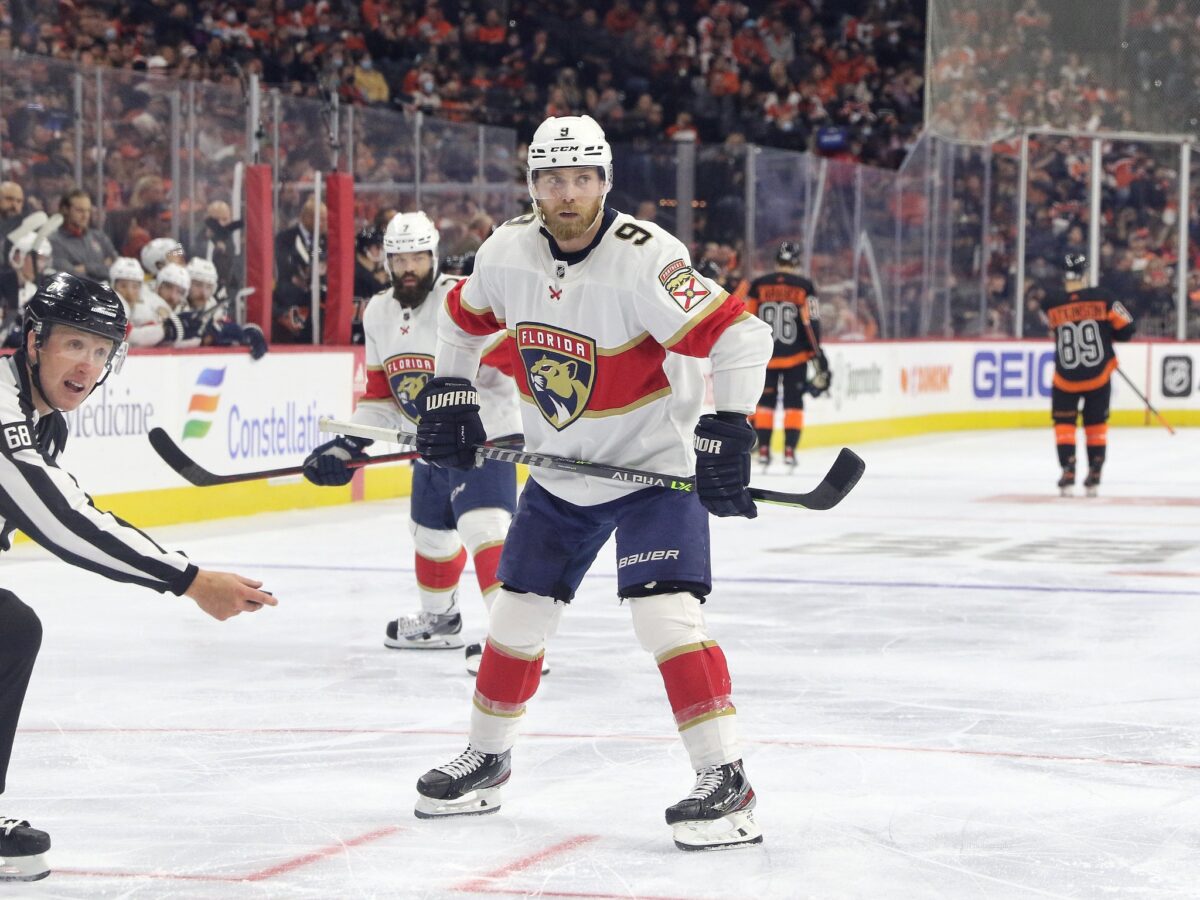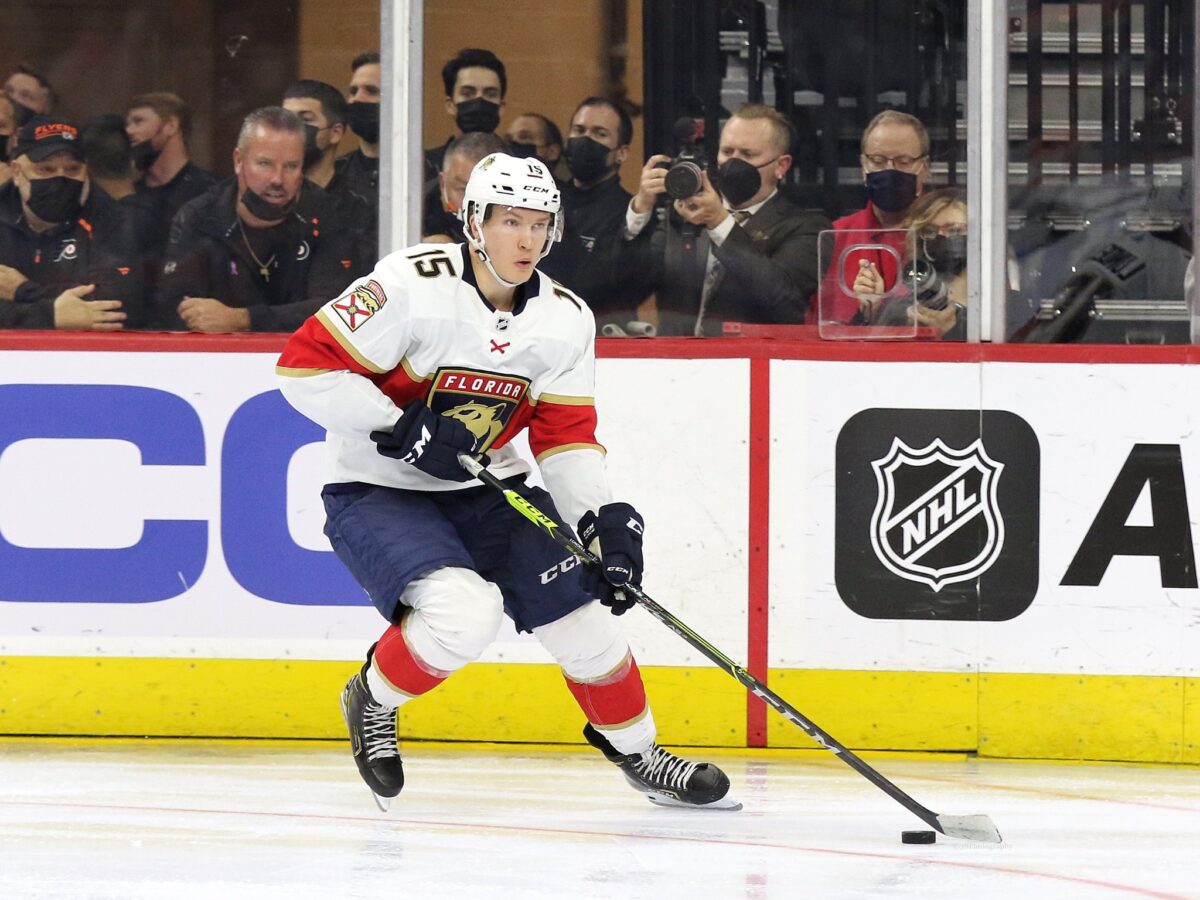There is no denying that replacing captain Aleksander Barkov in this Florida Panthers lineup will be a difficult task. Despite the difficulty, the Panthers have no choice after Barkov left Tuesday’s game with a cringe-worthy injury after a knee-on-knee collision with New York Islanders defenseman Scott Mayfield. Barkov is listed as week-to-week, meaning if he’s out the minimum timeline of two weeks, the Panthers will need to replace his offensive and defensive production for at least their next eight games. Here’s how they can manage to do just that.
Barkov’s Impressive Five-on-Five Production
Barkov is an elite NHL center, especially at even strength. In 15 games this season, he has recorded 17 points, with all but two of those points coming at even strength. If Max Pacioretty — who has only played two games so far this season — is excluded, Barkov ranks tied for seventh among NHL forwards in on-ice goals for percentage of those who see more than 13 minutes of five-on-five ice time per game.
Related: Aleksander Barkov’s Path to Becoming Panthers’ Greatest Goal Scorer
Defensively, Barkov has picked up right where he left off last season as well. He is a plus-11, which ties him with three others for the best plus-minus rating among NHL centers. He is averaging over 20 minutes of ice time a game and leads all NHL forwards in takeaways. All told, he is continuing the production on both sides of the puck that saw him win the 2021 Selke Trophy as the league’s best defensive forward.
Replacing a better than point per game player and nine goals of offensive production is hard enough, but the Panthers will also need to replace Barkov’s production on the defensive side of the puck. That task is a large one at five-on-five, but it also includes replacing a handful of minutes he spends on the penalty kill as well. Here’s how they’ll attempt to do it.
The Panthers’ New Top Line
In Barkov’s absence, it appears the first option for interim head coach Andrew Brunette is a return of the colloquially called ‘9-1-1’ line with Sam Bennett, Anthony Duclair, and Jonathan Huberdeau, who wear numbers nine, 10, and 11, respectively. Huberdeau and Bennett have been a staple all season long, with Tuesday night’s game against the Islanders being the only time Huberdeau had slotted alongside a center other than Bennett when both were healthy.

Defensively, Duclair leads the league in plus/minus among forwards, and Bennett is close behind at plus-10. Though some of Duclair’s defensive production can be attributed to playing with Barkov all season, this group of forwards is still a productive two-way unit. Duclair, widely noted as one of the fastest players in the game, has the speed necessary to join the rush and still effectively get back in the play defensively. The coaching staff will look to him to do just that to help offset the defensively responsible Barkov.
On the offensive side of the puck, this new line is not only quick but likes to shoot. Though this new line may miss Barkov’s puck possession advantage, they will shoot the puck at a similar clip to the previous line of Duclair, Barkov, and Carter Verhaeghe. Despite Barkov leading the Panthers in shots this season, Bennett is close behind and actually leads the team in shots per game played. This line may not hold the puck in the offensive zone as long as a Barkov led unit, but they will use their speed and shot-first preferences to crash the net, leading to plenty of offensive chances.
Ripples Down the Panthers Lineup
The Barkov injury is the first real chance for the Panthers to test the impressive depth they built in the offseason. Up until this point, Noel Acciari is the only other Panther to be sidelined with an injury of any real severity. Bennett, Anton Lundell, and others have missed a few games, but nothing more than day-to-day injuries. This time, however, the Panthers’ lines will fundamentally change.
Down the middle, the most notable change will be the insertion of veteran forward Joe Thornton into the lineup on a regular basis. Thornton has only played in six games so far this season, though he has seen time on the second power-play unit when in the lineup. He’ll draw back in with regularity to center the third line between shoot first forwards Frank Vatrano and Owen Tippett. Expect Thornton’s ice time to increase substantially to the 14- or 15-minute mark, up from the current 10 minutes of ice time he’s averaged this season.

On the second unit, rookie Anton Lundell will play a much larger role. Not only will he center Verhaeghe and Sam Reinhart, by far the most offensive talent he’s played with in his young career, but he’ll also feature more prominently on the penalty kill to help take important faceoffs and eat valuable minutes left vacant by Barkov’s injury. This is an excellent opportunity for Lundell to continue to develop his two-way play and build confidence among the Panthers’ coaching staff to deploy him in high-leverage, late-game situations.
When it comes to the fourth and final line of the forward corps, Brunette and the coaching staff maintain some impressive flexibility. Any combination of Patric Hornqvist, Ryan Lomberg, Eetu Luostarinen, and Maxim Mamin could be utilized before management even considers a potential call-up, such as Zac Dalpe, should Barkov require time on the injured reserve list.
What to Watch For:
All that said, two key questions remain in the Panthers’ efforts to temporarily replace Barkov’s production. First, the new top line will have to carry more of the offensive load than previously. That work starts with Huberdeau, who does have 15 points in 16 games. Despite that near point per game clip, he will need to pick up the scoring pace, given he has scored goals in just four of the Panthers’ contests to date.
The second key question surrounds the increased responsibility for Lundell. Centering the second line, he will be relied upon to take up more ice time, win important defensive zone faceoffs, and spend more time on the penalty kill. Though he is playing with two offensively gifted linemates for the first time in his career, he’ll need to show his ability to be a mini-Barkov and excel on both sides of the puck.
Ultimately, the Panthers play five times in the next 10 days, with four of those games coming against teams well above a .500 winning percentage. Without their captain, the task ahead is a difficult one but, given their forward depth, it is a challenge they are built to face.